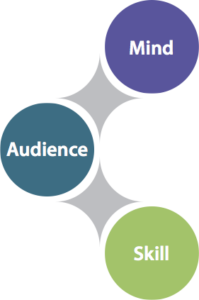 How Do You Know if You’ve Given a “Good” Speech?
How Do You Know if You’ve Given a “Good” Speech?
As public speakers, we want to do our best.
But presentations can be hard to evaluate. Was it a good speech if:
- You felt comfortable?
- The audience was engaged (and what about the audience that’s hung over, only got 3 hours of sleep last night, and would probably snooze through a Tony Robbins presentation)?
- The person who hired you was satisfied?
Or can a talk only be “good” if it meets the high standard of a TED talk?
What Is a TED Talk, and What Standard Does It Set?
For those of you who don’t follow speechmaking fashions, a “TED talk” originally meant nothing more than “a talk that was presented at a thought-leader conference called TED.” (TED stands for technology, entertainment, design. The organization’s tag line is “Ideas Worth Spreading.”)
That was more than 30 years ago.
But today, thanks to the Internet, TED has evolved into an 800-pound gorilla in the public speaking forest. Millions of people have watched hundreds of TED talks online, and for many of them, TED talks have become synonymous with public speaking excellence.
These talks follow specific “performance practices” (a/k/a conventions, or even rules).
They are:
- “Informal” and “conversational”
- Provocative or counter-intuitive
- Delivered without notes, and no podium
- Dramatic, with at least one story
- Structured in a “free-flowing” way (as opposed to the classic rhetorical structure embodied by the Instant Speech format)
Is this approach to public speaking valid, effective, and entertaining ? Yes.
Is it the right approach for business speakers?
In general, I don’t think so!
Want Help with a TED-Style Talk?
How the “TED” Ideal is Ruining Business Presentations
OK, that’s hyperbole.
TED can’t ruin business presentations, because most of them are pretty awful to begin with.
But what TED can do — and has done to lots of people — is add a layer of unrealistic expectations to the already-impossible demands of business speaking.
Why is business speaking so tough? It’s not unusual to:
- Receive a speaking assignment at the last minute;
- Know little or nothing about your audience;
- Have to deliver someone else’s message (which you may or may not agree with); and
- Be stuck with a PowerPoint that was designed (at the last minute) by someone who’s not invested in your speech and doesn’t know the first thing about how to design slides.

Even when you’re the master or mistress of your own content, business presentations are generally lousy because almost no one knows how to prepare, practice, or present them.
(The second chapter of my book, Speak Like Yourself… No, Really!, is devoted to the standard “doomed to fail” approach to business presentations, which usually begins with a data dump.)
When you take this already loaded situation and add the expectation that you’ll get up and speak without notes, conversationally, with the sophisticated cool of an ideal TED presenter… things are really stacked against you.
What’s the Secret to TED Speakers’ Smooth Success?
I’m often approached by prospective corporate clients who want me to turn their executive speakers into TED-style presenters — in 30 minutes, on the morning they’re scheduled to present!
Trust me, it doesn’t work like that.
Having proudly prepared speakers for both TEDx gatherings and the TED main stage, I can tell you that the TED process is elaborate and intensive:
- First, a TED speaker writes – and rewrites, and rewrites – a script, often with professional help.
- The script is then vetted by the TED organization, which may suggest edits and even major revisions.
- The speaker then creates slides and other visual props to support their speech, often with professional help. These are also vetted by TED staff.
- Over a period of weeks, or more likely months, the speaker will memorize his or her remarks and practice them over and over and over again, often with professional help. Susan Cain, the author of Quiet: The Power of Introverts in a World that Can’t Stop Talking famously spent a year practicing her TED talk.
- TED speakers rehearse several times in front of groups of other TED speakers, and will have at least one dress / technical rehearsal on the main TED stage, under the guidance of their TED-assigned speaker coach.
- All of this will culminate in a presentation that is (a) professionally lit; (b) professionally mic-ed; (c) videotaped by multiple professional camera operators; and (d) — THIS IS IMPORTANT, EVERYONE! — edited so that the speaker is shown from different points of view.
Gee, why don’t the rest of us look that good every time we’re called on to speak??!!!
Want Help with a TED-Style Talk?
What’s a Business Speaker to Do about TED-Sized Expectations?
The first step is to manage those expectations — your own, and other people’s.
- If your manager thinks that you should be presenting a speech that you were assigned to give two days beforehand without notes, gently remind him or her that:
- Memorization takes a lot of time and effort, and
- You have an actual job to perform for the next two days, while you’re creating and practicing this speech.
- If you believe that you should be able to flawlessly deliver a speech that your team won’t finish writing until 9pm the night before you give it, gently remind yourself that:
- There’s no such thing as flawlessness,
- No one gets anywhere near “great” without lots and lots of practice, and
- Staying up all night to cram a speech does not produce the desired effect. (There’s lots of information here about what is effective when it comes to practicing.)
In this situation, take your speaking notes onstage, be yourself, and do your best; that’s all that anyone can reasonably do in two days (which is way more time than many business speakers are given to prepare and practice their presentations.
Finally,
- If you’re in charge of a team presentation or an event, don’t trust anyone who tells you they can make your speakers into TED clones in 30 minutes on the day that they’re presenting. If you want a TED-like outcome:
- Commit to starting early,
- Get people onboard who know what they’re doing (like me), and remember that you still aren’t going to get perfection because (a) there is no such thing, and (b) your people have jobs. Many TED speakers take leaves of absence from their jobs to prepare — and since you’re probably not offering that option to your people, it’s not fair to expect them to work full time AND prepare full time to give a top level TED-style presentation.
So, Am I a TED Hater?
Not at all!
TED has done wonderful things for my industry (speaker coaching), inspired millions of people, spread important ideas, and helped all of us envision a world in which speeches are worth listening to.
Someday, that ideal will truly be embraced by business.
But until the moment when you’re given a team of experts to help create your presentation — and weeks or months off to write and practice it! — please don’t hold yourself or your employees to the TED standard.
There’s nothing wrong with giving a solid, interesting business speech… and that is something you can achieve!

 Buy 100 Top Public Speaking Tips: The Book!
Buy 100 Top Public Speaking Tips: The Book!
In 25 years of speaker coaching, I’ve helped my individual speaker coaching clients develop their strengths and skills to become authentic and effective communicators.
Along the way, I’ve developed tips for everything from small talk to speaking up in meetings, from managing fear to making an impact.
And now, I’ve shared it all in 100 Top Public Speaking Tips: The Book. This beautifully designed PDF booklet is searchable, clickable, and categorized, so that you can find what you need, instantly.
